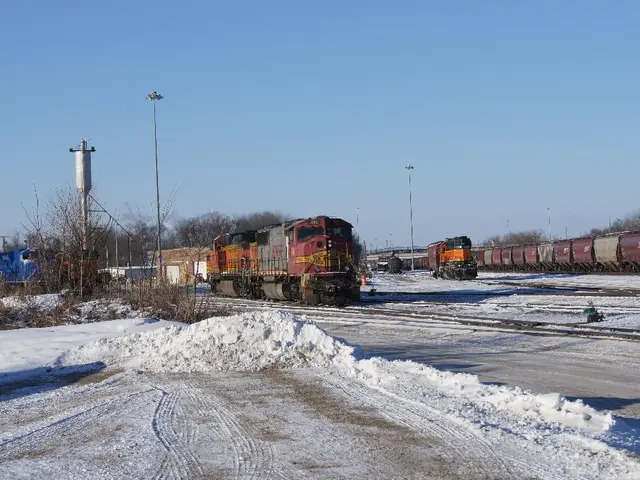Pakistan's recently inaugurated Balochistan airport is yet to witness the influx of travelers.
Located in the coastal city of Gwadar and completed in 2024, the airport serves as a stark contrast to the poverty-stricken, tumultuous southwestern Balochistan province that surrounds it. Over the past decade, China has invested heavily in Balochistan and Gwadar as part of a multibillion-dollar endeavor, known as the China-Pakistan Economic Corridor (CPEC), connecting its Xinjiang province with the Arabian Sea.
While authorities laud CPEC as transformative, there's little evidence of change visible in Gwadar. The city isn't connected to the national grid, relying on electricity from neighboring Iran or solar panels, and clean water remains scarce. A modern, 400,000-passenger-capacity airport seems an unneeded luxury for the city's 90,000 inhabitants.
"This airport is not for Pakistan or Gwadar," noted Azeem Khalid, an international relations expert specializing in Pakistan-China relations. "It's for China, so they can have secure access for their citizens to Gwadar and Balochistan."
CPEC's advancements have only fueled an insurgency within resource-rich, strategically located Balochistan. Separatists, seeking independence due to what they consider state exploitation, engage in violence against both Pakistani troops and Chinese workers. Pakistani forces hasten to protect China's investments, reinforcing Gwadar with checkpoints, barbed wire, troops, barricades, and watchtowers.
Local residents feel wary of these constant intrusions. "Nobody used to ask where we were going, what we were doing, and what is your name," recalls 76-year-old Gwadar native Khuda Bakhsh Hashim. Strangers once enjoyed all-night picnics, but now, the slightest questions trigger demanded identification.
Hashim reminisces about a time before CPEC, when Gwadar was part of Oman and a stopover for passenger ships headed to Mumbai. Locals lacked nothing, and there was always an abundance of drinking water. Today, however, Gwadar's water dries up due to drought and unchecked exploitation, and joblessness casts a shadow over the city.
Government officials assert that CPEC has created 2,000 local jobs, but without clarifying if they mean Baloch residents or Pakistanis from other provinces. The city's locals decry a lack of opportunity and economic improvement as a result of CPEC.
CPEC's impact on Gwadar remains debated, with locals muddled between excitement for the promised benefits and apprehension over the realities unfolding before their eyes.
CPEC's impact on Gwadar's infrastructure, employment, and local sentiment is considerable, with mixed results:
Infrastructure
- Gwadar Port: Development of the Gwadar Port serves as a significant component of CPEC, with substantial investments to upgrade its size and capabilities. However, the port primarily operates in transit, rendering minimal commercial activity, and has reportedly been running at a loss[1].
- Airport: The construction of a new international airport in Gwadar is an impressive feat, boasting a 400,000-passenger capacity. Yet, many question the necessity of such a massive airport for the city's small population and limited economic activity, often referring to the airport as a 'commercial white elephant.'
- Railway and Road Upgrades: Plans involve modernizing Pakistan's railway network, with Gwadar's connectivity among the priorities. Delays and security challenges have impeded progress, however[5].
Employment
- Limited Opportunities: Despite infrastructure development, CPEC has failed to generate substantial employment opportunities for local residents. Many projects are slammed for not providing significant local benefits, leading to widespread disillusionment and unrest.
- Chinese Workforce: The influx of Chinese workers has exacerbated feelings of inequality, as locals take issue with the skewed economic benefits between Chinese and Balochi citizens[1].
Local Sentiment
- Discontent and Resentment: Local residents grow increasingly disillusioned with CPEC, asserting that it has not delivered the promised economic prosperity and instead has transformed Gwadar into a high-security zone.
- Cultural and Environmental Concerns: CPEC-related projects, such as a donkey slaughterhouse intended for traditional Chinese medicine, have provoked outrage among locals, further fueling the perception that CPEC is exploiting the region's resources without delivering adequate benefits[1].
Balochi residents look to CPEC with both optimism and fear, uncertain of what the future holds for their city. Since its inception, CPEC has delivered significant infrastructure investments, yet its promise of widespread economic benefits has fallen short. The project's legacy in Gwadar remains uncertain, leaving locals to navigate the changing landscape of their once-peaceful coastal community.
[1] https://www.iep.utm.edu/china-pak/[2] https://www.aljazeera.com/news/2018/8/14/captured-parkar-brahumdagh-baloch-in-pakistan-interview[3] https://gwadarfocus.com/cpec-news/cpec-oil-refinery-project/[4] https://france24.com/en/live-news/20211228-pakistans-balochistan-province-protests-over-chinas-cpec-project[5] https://www.dawn.com/news/1675256/cpec-projected-to-cut-transport-costs-in-half
- Despite the completion of the new airport in Gwadar in 2024, which is expected to have a capacity of 400,000 passengers, there are concerns among local residents about its necessity, especially given the city's small population and limited economic activities.
- The development of the Gwadar Port, a significant component of the China-Pakistan Economic Corridor (CPEC), has attracted substantial investments, but criticism has arisen over its minimal commercial activity and running at a loss.
- In 2024, during a panel discussion focusing on Balochistan's news and developments, the impact of CPEC on Gwadar's infrastructure, employment, and local sentiment will be a hot topic, withBalochi residents demonstrating a mix of optimism and fear for their city's future.








